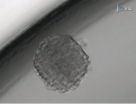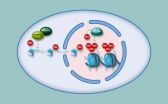(Press-News.org) CHICAGO—In today's fast-paced society, consumers often reach for nutrition bars when looking for a healthy on-the-go snack. A new study in the September issue of the Journal of Food Science published by the Institute of Food Technologists (IFT) found that partially replacing canola oil with fish oil in nutrition bars can provide the health benefits of omega-3 fatty acids without affecting the taste.
Producers have been hesitant to incorporate fish oil into foods because it tends to give off a fishy taste or smell, therefore requiring additional processing steps to eliminate these unwanted qualities. In the study, four levels of fish oil were evaluated to determine consumer acceptance of fish-oil fortified nutrition bars. The results showed that oat and soy-based nutrition bars fortified with the lowest replacement level (20 percent) of fish oil did not affect consumer acceptance or purchase intent.
Omega-3 fatty acids from fish oil are known to lower triglyceride levels and may help with rheumatoid arthritis.
###
About IFT
For more than 70 years, IFT has existed to advance the science of food. Our nonprofit scientific society—more than 18,000 members from more than 100 countries—brings together food scientists, technologists and related professions from academia, government, and industry. For more information, please visit ift.org.
Nothing fishy about fish oil fortified nutrition bars
2012-09-25
ELSE PRESS RELEASES FROM THIS DATE:
Cost-efficient method developed for maximizing benefits from wine waste
2012-09-25
CHICAGO—A new study in the Journal of Food Science, published by the Institute of Food Technologists (IFT), shows that grape skin and seeds generated from winemaking—known as wine pomace—are a good source of antioxidant dietary fiber and can be used to fortify various food products such as yogurts and salad dressings with enhanced nutritional value and extended shelf-life.
The researchers from Oregon State University analyzed pomace from Pinot Noir and Merlot wines to determine the most economically feasible ways to convert the rich source of antioxidants in pomace into ...
Into the mind of the common fruit fly
2012-09-25
Although they're a common nuisance in the home, fruit flies have made great contributions to research in genetics and developmental biology. Now a Tel Aviv University researcher is again turning to this everyday pest to answer crucial questions about how neurons function at a cellular level — which may uncover the secrets of neurological disorders such as Alzheimer's disease.
Approximately 75 percent of the genes that are related to diseases in humans are also to be found in the fly, says Ya'ara Saad, a PhD candidate in the lab of Prof. Amir Ayali at TAU's Department ...
Georgia Tech creating high-tech tools to study autism
2012-09-25
Researchers in Georgia Tech's Center for Behavior Imaging have developed two new technological tools that automatically measure relevant behaviors of children, and promise to have significant impact on the understanding of behavioral disorders such as autism.
One of the tools—a system that uses special gaze-tracking glasses and facial-analysis software to identify when a child makes eye contact with the glasses-wearer—was created by combining two existing technologies to develop a novel capability of automatic detection of eye contact. The other is a wearable system that ...
After a 2-year slowdown, health spending grew 4.6 percent per capita in 2011, says HCCI report
2012-09-25
Washington, DC—U.S. health care spending grew at a faster pace than expected in 2011,
according to a new report from the Health Care Cost Institute (HCCI). The Health Care Cost and
Utilization Report: 2011 provides the first broad look at 2011 health care spending among those
with employer-sponsored insurance (ESI). HCCI found that average dollars spent on health care
services for that population climbed 4.6 percent in 2011, reaching $4,547 per person. This was
well above the 3.8 percent growth rate observed in 2010 and beyond expected growth for
2011.
Consumers ...
Language use is simpler than previously thought, finds Cornell study
2012-09-25
ITHACA, N.Y. — For more than 50 years, language scientists have assumed that sentence structure is fundamentally hierarchical, made up of small parts in turn made of smaller parts, like Russian nesting dolls. But a new Cornell University study suggests language use is simpler than they had thought.
Co-author Morten Christiansen, Cornell professor of psychology and co-director of the Cornell Cognitive Science Program, and his colleagues say that language is actually based on simpler sequential structures, like clusters of beads on a string.
"What we're suggesting is ...
Study of cigarette and waterpipe tobacco smoking shows knowledge gap in perceived health risks
2012-09-25
RICHMOND, Va. (Sept. 25, 2012) – People who smoke both cigarettes and waterpipes – dual users – lack sufficient knowledge about the risks of tobacco smoking and are at considerable risk for dependence and tobacco-related diseases, such as cancer, heart disease and stroke later in life, according to findings of a new study by Virginia Commonwealth University.
The study, the first of its kind to assess trends in cigarette and waterpipe tobacco smoke based on long-term data, reveals few users perceive dangers of waterpipe tobacco. A common misconception about waterpipe ...
Mechanism that leads to sporadic Parkinson's disease identified
2012-09-25
New York, NY (September 25, 2012) — Researchers in the Taub Institute at Columbia University Medical Center (CUMC) have identified a mechanism that appears to underlie the common sporadic (non-familial) form of Parkinson's disease, the progressive movement disorder. The discovery highlights potential new therapeutic targets for Parkinson's and could lead to a blood test for the disease. The study, based mainly on analysis of human brain tissue, was published today in the online edition of Nature Communications'.
Studies of rare, familial (heritable) forms of Parkinson's ...
News consumption of political stories not enough to retain political knowledge
2012-09-25
A strong democracy depends on smart voters who choose their leaders based on their knowledge of important political issues. One of the ways that Americans learn about politics is by following the news. Now, researchers from the University of Missouri School of Journalism have found that simply following the news is not enough.
A panel survey involving more than 1,200 teenagers from 12 to 17 years of age found that adolescents learn more about politics when they think and talk about what they read or watch on the news. Edson Tandoc, a doctoral student at MU, found that ...
JoVE article shows steps to isolate stem cells from brain tumors
2012-09-25
September 25, 2012
A new video protocol in Journal of Visualized Experiments (JoVE) details an assay to identify brain tumor initiating stem cells from primary brain tumors. Through flow cytometry, scientists separate stem cells from the rest of the tumor, allowing quick and efficient analysis of target cells. This approach has been effectively used to identify similar stem cells in leukemia patients.
"Overall, these tumors are extremely rare, with only around one in 100,000 people being diagnosed with a primary brain cancer," Dr. Sheila Singh, co-author and neurosurgeon ...
Making and breaking heterochromatin
2012-09-25
This press release is available in German.
To fit the two-meter long DNA molecule into a cell nucleus that is only a few thousandths of a millimetre in size, long sections of the DNA must be strongly compacted. Epigenetic marks maintain these sections, known as heterochromatin. Scientists of the Max Planck Institute of Immunobiology and Epigenetics in Freiburg have now discovered two further mechanisms necessary for the formation of heterochromatin. The research group, led by Thomas Jenuwein, describes two novel enzymes, Prdm3 and Prdm16, which attach a methyl group to ...


